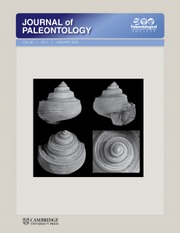As many of us know, there is no place that Carl Brett would rather be during any waking moment than out in the field. Carl likes to put his eyes very close to the outcrop, and he has an innate ability to quickly diagnose unique attributes of individual horizons—unusual colors, modes of fossil preservation, depositional styles, ephemeral occurrences of taxa—that set them apart from their stratigraphic neighbors. Carl's boundless energy, encyclopedic memory of minute details, and talent for on-the-spot synthesis enable him to then quickly traverse numerous localities to determine whether these horizons are recognizable elsewhere, which they often are, even in the face of significant, lateral changes across a basin in their other internal characteristics.
This painstaking modus operandi and Carl's extraordinary powers of synthesis have helped fuel his remarkable accomplishments in sequence and event stratigraphy. Carl and his collaborators have rewritten the stratigraphic frameworks of the Appalachian Basin, Cincinnati region, and elsewhere worldwide, increasingly integrating stable-isotopic, as well as faunal and lithological patterns into the mix, and determining the extent to which regional, stratigraphically confined patterns can be global in scope. These determinations lie at the heart of developing a truly integrative, high-resolution approach to Earth system history and have been evident in his papers since the 1990s.
Carl spent his early childhood in New Hampshire, but moved at age ten to Grand Island in western New York where his father took a faculty position at Buffalo State. After the move, Carl quickly became fascinated by a chunk of Ordovician sandstone in his new backyard that contained a mold of the prolific bivalve, Ambonychia Hall, 1847. He soon found additional fossils and became hooked on paleontology, as an artist and scientist. Through his high school years, his burgeoning, self-directed scientific interests in fossils quickly overtook his artistic endeavors, and, as a senior, Carl won the annual New York State Science Fair competition in 1969 for a study of size variation in the trilobite Phacops (now Eldredgeops) rana (Green, 1832) through the Hamilton Group in western New York.
Carl completed his Bachelor's and Master's degrees at the University of Buffalo in 1973 and 1975, where he was mentored by Ed Buehler, a specialist in Devonian corals. Coming out of Buffalo, Carl's interests turned to crinoids, and he moved to the University of Michigan for his Ph.D., where he worked with Brad Macurda. Carl completed his dissertation and took his first faculty position, at the University of Rochester, in 1978. He moved to the University of Cincinnati in 1998, where he has been happily ensconced for the past 26 years. While at Cincinnati, Carl has received many international and national awards and is now a University Distinguished Research Professor. He has served as primary research advisor to some 60 graduate students and has advised countless other grads and undergrads.
Although Carl is now rightfully regarded as perhaps the preeminent stratigraphic paleontologist on the planet, his accomplishments in taphonomy, macroevolution, and paleoecology are just as significant. Here are a few notable examples:
(1) Carl's findings with his close research partner, Gordon Baird, that regional Silurian and Devonian biotas of the Appalachian Basin collectively exhibited intervals of relative, multispecies stasis, punctuated by shorter-duration intervals of biota-wide change. Dubbed ‘coordinated stasis,’ these findings significantly raised the stakes in the debate about Eldredge and Gould's earlier theory of punctuated equilibrium. Although not without controversy when introduced in the mid-1990s, coordinated stasis motivated extensive, still-ongoing reinvestigation by colleagues worldwide of the fabric of stratigraphic and macroevolutionary change at multiple spatiotemporal scales.
(2) His establishment in the 1980s of a practical, diagnostic framework for understanding taphonomic impacts in organismal and environmental contexts, which Carl dubbed ‘comparative taphonomy,’ and the attendant concept of ‘taphofacies.’ This work has provided conceptual and practical tools for diagnosing how taphonomic effects can vary among different organisms or environments, and for relating these features to depositional conditions and, in some cases, associated cyclicity.
(3) Building off the taphofacies approach, Carl's work with colleagues using a submersible in the 1990s and early 2000s to deploy and periodically retrieve experiments from deepwater settings. Known as the Shelf-and-Slope Taphonomic Initiative (SSETI), Carl and his colleagues determined how biotic remains degrade or are preserved across shelf and slope gradients in carbonate and siliciclastic regions.
(4) Carl's documentation in the 1980s of the Paleozoic precursors of the Mesozoic marine revolution, which fueled an extensive re-examination of evidence for biotic interactions throughout the Paleozoic Era.
Carl believes that to really grasp and internalize the patterns and frameworks that he has diagnosed and written about copiously, a person must see them in the field. To this end, Carl has led an enormous number of field trips, many stretching through multiple days (and evenings!), that bring his work to life. Although it's hard to know for sure how many people Carl has hosted on field trips, it must surely be upward of 10,000+ by now.
In this respect and others, Carl is incredibly generous with his time and exudes an infectious, positive spirit that has inspired many students and early-career colleagues to vigorously pursue careers in paleontology, often helping them to conquer self-doubts along the way. Without question, these dimensions of Carl have been just as important as his intellectual contributions to advancing and sustaining the science of paleontology worldwide through the past several decades.
It is an honor and a pleasure to present the 2023 Paleontological Society Medal to Carlton E. Brett.



